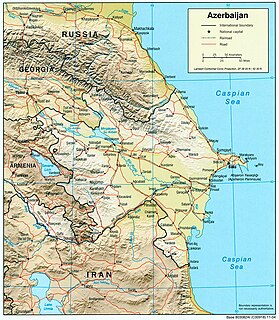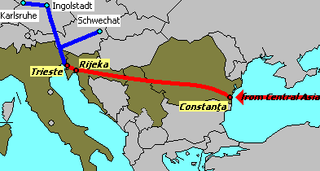
The Strait of Hormuz is a strait between the Persian Gulf and the Gulf of Oman. It provides the only sea passage from the Persian Gulf to the open ocean and is one of the world's most strategically important choke points. On the north coast lies Iran, and on the south coast the United Arab Emirates and Musandam, an exclave of Oman. At its narrowest, the strait has a width of 21 nautical miles (39 km).
Transport in Turkmenistan includes such as roadways, railways, airways, seaways, waterways, oil, gas and water pipelines.

The transport in Azerbaijan involves air traffic, waterways and railroads. All transportation services in Azerbaijan except for oil and gas pipelines are regulated by the Ministry of Transportation of Azerbaijan Republic.

The Baku–Tbilisi–Ceyhan (BTC) pipeline is a 1,768 kilometres (1,099 mi) long crude oil pipeline from the Azeri–Chirag–Gunashli oil field in the Caspian Sea to the Mediterranean Sea. It connects Baku, the capital of Azerbaijan and Ceyhan, a port on the south-eastern Mediterranean coast of Turkey, via Tbilisi, the capital of Georgia. It is the second-longest oil pipeline in the former Soviet Union, after the Druzhba pipeline. The first oil that was pumped from the Baku end of the pipeline reached Ceyhan on 28 May 2006.

Petroleum politics have been an increasingly important aspect of diplomacy since the rise of the petroleum industry in the Middle East in the early 20th century. As competition continues for a vital resource, the strategic calculations of major and minor countries alike place prominent emphasis on the pumping, refining, transport, sale and use of petroleum products. However, international climate policy and unconventional oil and gas developments may change the balance of power between petroleum exporting and importing countries with major negative implications expected for the exporting states.

Tengiz field is an oil field located in northwestern Kazakhstan's low-lying wetlands along the northeast shores of the Caspian Sea. It covers a 2,500 km2 (970 sq mi) project license area which also includes a smaller Korolev field as well as several exploratory prospects.
The Odessa–Brody pipeline is a crude oil pipeline between the Ukrainian cities Odessa at the Black Sea, and Brody near the Ukrainian-Polish border. There are plans to expand the pipeline to Płock, and furthermore to Gdańsk in Poland. The pipeline is operated by UkrTransNafta, Ukraine's state-owned oil pipeline company.

Kashagan Field is an offshore oil field in Kazakhstan's zone of the Caspian Sea. The field, discovered in 2000, is located in the northern part of the Caspian Sea close to Atyrau and is considered the world's largest discovery in the last 30 years, combined with the Tengiz Field.
The Caspian Pipeline Consortium is a consortium and a pipeline to transport Caspian oil from Tengiz field to the Novorossiysk-2 Marine Terminal on Russia's Black Sea coast. It is also a major export route for oil from the Kashagan and Karachaganak fields. As of 2009, the CPC pipeline is the only oil export pipeline in Russian territory not wholly owned by Transneft.

The Trans-Caspian Gas Pipeline is a proposed subsea pipeline between Türkmenbaşy in Turkmenistan, and Baku in Azerbaijan. According to some proposals it will also include a connection between the Tengiz Field in Kazakhstan, and Türkmenbaşy. The Trans-Caspian Gas Pipeline project is purposed to transport natural gas from Turkmenistan and Kazakhstan to European Union member countries, circumventing both Russia and Iran. It is also considered as a natural eastward extension of Southern Gas Corridor. This project attracts significant interest since it will connect vast Turkmen gas resources to major consumer geographies as Turkey and Europe.

The Pan-European Oil Pipeline (PEOP) is a proposed oil pipeline from Constanţa in Romania via Serbia and Croatia to Rijeka and from there through Slovenia to Trieste in Italy. The aim of the pipeline is to bypass Turkish straits in the transportation of Russian and Caspian oil to Central Europe. In Trieste the pipeline will be connected with the Transalpine Pipeline, running to Austria and Germany.
The Trans-Caspian Oil Transport System is a proposed project to transport oil through the Caspian Sea from Kazakhstani Caspian oilfields to Baku in Azerbaijan for the further transportation to the Mediterranean or Black Sea coast. The main options under consideration are an offshore oil pipeline from Kazakhstan to Azerbaijan, and construction of oil terminals and oil tankers fleet. A strong push for the project has been from the partners of the Kashagan oilfield project and in particular Total who has a share in both the field and the BTC pipeline. They have estimated that such a project would cost roughly US$4 billion. The project also faces opposition from Iran and Russia, both alternative avenues for Kazakhstan's oil and gas who would likely object to competing pipelines being built.

The Central Asia – Center gas pipeline system is a Gazprom controlled system of natural gas pipelines, which run from Turkmenistan via Uzbekistan and Kazakhstan to Russia. The eastern branch includes the Central Asia - Center (CAC) 1, 2, 4 and 5 pipelines, which start from the south-eastern gas fields of Turkmenistan. The western branch consists of the CAC-3 pipeline and a project to build a new parallel Caspian pipeline. The western branch runs from the Caspian Sea coast of Turkmenistan to north. The branches meet in western Kazakhstan. From there the pipelines run to north where they are connected to the Russian natural gas pipeline system.
Kazakhstan owns large reserves of energy resources, and therefore the energy policy of Kazakhstan has influence over the world's overall energy supply. Although Kazakhstan has not described itself as an energy superpower, Kazakhstan's president Nursultan Nazarbayev has claimed Kazakhstan will become a factor of energy security in Asia and Europe. Kazakhstan has a strategic geographical location to control oil and gas flows from Central Asia to East (China) and West.

Iran and Turkmenistan share a common border of more than 1000 km. The two countries have good relations since Turkmenistan's independence from the Soviet Union in 1991. Since then, the two countries have enjoyed good relations and have cooperated in economic, transportation, infrastructure development, and energy sectors. The 2 nations have historic ties, with Turkmenistan being a part of ancient Persia and Greater Iran.

The Baku–Novorossiysk pipeline is an 1,330-kilometre (830 mi) long oil pipeline, which runs from the Sangachal Terminal near Baku to the Novorossiysk terminal at the Black Sea coast in Russia. The Azerbaijani section of the pipeline is operated by the State Oil Company of Azerbaijan Republic (SOCAR) and the Russian section is operated by Transneft.
The Baku–Batumi pipeline is the name given to several pipelines and pipeline projects to transport kerosene and crude oil from the Caspian region to the Georgian Batumi oil terminal at the Black Sea. When first constructed in 1906, it was the world's longest kerosene pipeline.

The Caspian Sea is the world's largest inland body of water, variously classed as the world's largest lake or a full-fledged sea. It is an endorheic basin located between Europe and Asia, to the east of the Caucasus Mountains and to the west of the broad steppe of Central Asia. The sea has a surface area of 371,000 km2 and a volume of 78,200 km3. It has a salinity of approximately 1.2%, about a third of the salinity of most seawater. It is bounded by Kazakhstan to the northeast, Russia to the northwest, Azerbaijan to the west, Iran to the south, and Turkmenistan to the southeast. The Caspian Sea is home to a wide range of species and may be best known for its caviar and oil industries. Pollution from the oil industry and dams on rivers draining into the Caspian Sea have had negative effects on the organisms living in the sea.

Jask is a city and capital of Jask County, Hormozgan Province, Iran. At the 2006 census, its population was 11,133, in 2,406 families.

For the economic effects refer to Economy of Iran.














